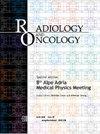妇产科中的紧急和预防性子宫动脉栓塞术--回顾性分析。
IF 2.1
4区 医学
Q3 ONCOLOGY
引用次数: 0
摘要
背景本研究旨在评估我们临床实践中急诊和预防性子宫动脉栓塞术(UAE)的安全性和有效性,包括技术成功率、临床成功率和相关并发症。在这项回顾性研究中,我们分析了 64 名接受急诊(n = 18)和预防性(n = 46)UAE 的女性。急诊 UAE 的指征包括产后出血或终止妊娠期间的严重出血,而预防性 UAE 则是在手术切除受孕滞留产物 (RPOC)、胎盘植入异常的分娩或终止妊娠(宫颈妊娠或胎儿异常并伴有胎盘植入异常)之前进行的。UAE的技术成功定义为完全排除血管病变和最终血管造影上造影剂瘀滞,而临床成功定义为UAE终止后出血停止且未切除子宫。结果在我们的研究中,UAE的总体临床成功率为97%(62/64)。预防组的所有栓塞手术在技术和临床上都很成功,没有出现危及生命的大出血或子宫切除术(成功率 100%,46/46)。然而,虽然急诊组的技术成功率同样达到了 100%,但有 89% 的病例(16/18)成功控制了出血。结论栓塞疗法是一种安全有效的方法,可用于处理原发性产后出血或终止妊娠期间的严重出血,以及降低手术切除 RPOC、胎盘植入异常分娩或妊娠期间严重出血的风险。本文章由计算机程序翻译,如有差异,请以英文原文为准。
Emergency and prophylactic uterine artery embolization in gynecology and obstetrics - a retrospective analysis.
BACKGROUND
This study aimed to evaluate the safety and efficacy of emergency and prophylactic uterine artery embolization (UAE) in our clinical practice, including technical success, clinical success, and associated complications.
PATIENTS AND METHODS
In this retrospective study, we analyzed 64 women who underwent emergency (n =18) and prophylactic (n = 46) UAE. Indications for emergency UAE included postpartum hemorrhage or severe hemorrhage during pregnancy termination, while prophylactic UAE was performed prior to surgical removal of retained products of conception (RPOC), delivery with abnormal placental implantation, or pregnancy termination (cervical pregnancy or fetal anomalies accompanied by abnormal placental implantation). Technical success of UAE was defined as complete exclusion of the vascular lesion and contrast stasis on the final angiogram, while clinical success was defined as cessation of bleeding after UAE Termination without a hysterectomy.
RESULTS
The overall clinical success of UAE in our study was 97% (62/64). All embolization procedures were technically and clinically successful in the prophylactic group without life-threatening hemorrhages or hysterectomies (100% success rate, 46/46). However, while 100% technical success was similarly attained in the emergency group, bleeding was successfully controlled in 89% of cases (16/18). In two patients with significant blood loss (over 2000 mL), embolization failed to achieve hemostasis, resulting in persistent bleeding and subsequent hysterectomy.
CONCLUSIONS
UAE is a safe and effective procedure for managing primary postpartum hemorrhage or severe hemorrhage during pregnancy termination and for decreasing the risk of severe hemorrhage during surgical removal of RPOC, delivery with abnormal placental implantation, or pregnancy.
求助全文
通过发布文献求助,成功后即可免费获取论文全文。
去求助
来源期刊

Radiology and Oncology
ONCOLOGY-RADIOLOGY, NUCLEAR MEDICINE & MEDICAL IMAGING
CiteScore
4.40
自引率
0.00%
发文量
42
审稿时长
>12 weeks
期刊介绍:
Radiology and Oncology is a multidisciplinary journal devoted to the publishing original and high quality scientific papers and review articles, pertinent to diagnostic and interventional radiology, computerized tomography, magnetic resonance, ultrasound, nuclear medicine, radiotherapy, clinical and experimental oncology, radiobiology, medical physics and radiation protection. Therefore, the scope of the journal is to cover beside radiology the diagnostic and therapeutic aspects in oncology, which distinguishes it from other journals in the field.
 求助内容:
求助内容: 应助结果提醒方式:
应助结果提醒方式:


